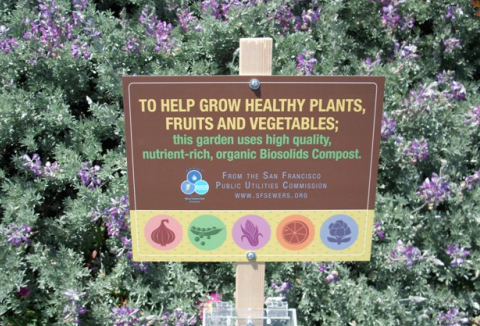More Free Sludge! Calabasas, California Offers Free Sewage Sludge "Compost"
 Good news! The sewage treatment plant in Calabasas, California has been giving away free sludge! Free sludge, you say? That potent stew of human and industrial sewage sludge laced with flame retardants, endocrine disruptors, pharmaceutical residues, phthalates, industrial solvents, resistant pathogens, and perfluorinated compounds? "Composted" sludge, which can bioaccumulate in plants grown in sludge-contaminated soil? Oh, goodie.
Good news! The sewage treatment plant in Calabasas, California has been giving away free sludge! Free sludge, you say? That potent stew of human and industrial sewage sludge laced with flame retardants, endocrine disruptors, pharmaceutical residues, phthalates, industrial solvents, resistant pathogens, and perfluorinated compounds? "Composted" sludge, which can bioaccumulate in plants grown in sludge-contaminated soil? Oh, goodie.
History of a Hoodwinking
As the Center for Media and Democracy's (CMD's) founder, John Stauber, previously reported, the San Francisco Public Utilities Commission started giving away sewage sludge, calling it "organic compost," in 2007. In 2010, Stauber -- who had retired from CMD -- discovered this and exposed it. CMD also helped break the news that independent tests of this sewage sludge-derived material from the Synagro CVC plant "found appreciable concentrations of contaminants with endocrine-disruptive properties." The independent tests were conducted by Dr. Robert C. Hale of the Virginia Institute of Marine Sciences.
The "biosolids" moniker -- which the SFPUC sometimes used to describe the material and which the Calabasas' Rancho Las Virgenes "Compost" Facility uses for its program as well -- is a PR euphemism chosen in a contest by the sludge-promotion trade group the Water Environment Federation (WEF), no newcomer to the PR technique of "rebranding." WEF's recent coinages include calling sewage treatment plants "water resource recovery facilities," as CMD's new Food Rights Network (FRN) recently reported.
At least Calabasas isn't calling its free sewage sludge "organic," a misleading term not referring to the U.S. Department of Agriculture's organic certification program and which San Francisco was forced to stop using to refer to its sludge slinging.
Closed for Maintenance
The Calabasas plant has been scurrying to give away all its sewage sludge, which it calls "compost," in order to empty out and close the plant for "refurbishments" that will take "several months," according to the Ventura County Star. The plant's head of PR, Jeff Reinhardt, says anyone who wants "free compost" may collect it from the facility.
The Calabasas plant is not a small one: it receives 120,000 gallons a day of liquid sewage sludge from the Tapia sewage plant in Malibu Canyon and produces 11,000 cubic yards of partially dewatered sewage sludge, which it calls "biosolids compost," each year. The facility has been in almost continuous use for 20 years, and according to Reinhardt, "gases produced during the process are corrosive to some of the building components, so part of the shutdown is to carry out repairs to the main building where composting takes place. ... [W]e need to give the cure building where the compost ages a good clean." He did not elaborate on the types of corrosive gases released from the sludge.
Where to Dump the Sludge: Kern County, of Course!
While part of the plant is closed, dried and "digested" sludge will be dumped in Kern County, California. As FRN has previously reported, Kern County has the sad role of basically being southern California's toilet. The county banned sludge dumping in 2006 in order to keep populous Los Angeles County from dumping its sewage sludge in Kern, but L.A. County sued and won an injunction, which was overturned by the Ninth Circuit Court of Appeals in 2009. But L.A. County took the county back to court before the ban could take effect in October, and a tentative ruling put the ban on hold again.
This means Kern County still receives hundreds of tons a day of L.A. County sludge, despite the democratic vote against this practice. In the next few months, Calabasas will be sending a little extra their way.
"Minimal Heavy Metal Content"?
The Ventura County Star reports that the sewage sludge processed at Rancho Las Virgenes "is graded by the Environmental Protection Agency as 'Class A-Exceptional Quality' and has a minimal heavy metal content." The EPA's biosolids "classes" concern pathogens, but the only pathogens actually measured and regulated in the law are fecal coliform and salmonella. Despite assurances of safety, the EPA's requirements for "Class A Biosolids" do nothing to regulate or limit numerous other contaminants routinely found in sewage sludge. Only ten heavy metals are regulated to limited concentrations in "Class A" sludge. These regulations also do not limit other carcinogens and endocrine disruptors in sewage sludge.
These limits didn't protect the McElmurrays in Georgia, whose land became "too polluted by PCBs, chlordane, heavy metals, and other hazardous wastes in Augusta's sewage sludge to grow foodchain crops," according to Robert McElmurray, III's testimony to the U.S. Senate in 2008, a claim which was upheld in court.
Gardeners considering using this "free resource" from the city of Calabasas should think again before subjecting their gardens to similar contamination.




